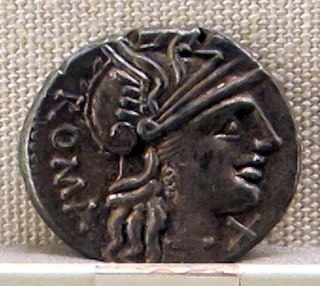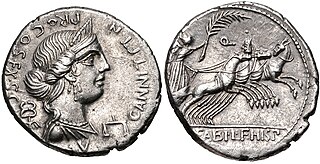Related Research Articles
The gens Acilia was a plebeian family at ancient Rome, that flourished from the middle of the third century BC until at least the fifth century AD, a period of seven hundred years. The first of the gens to achieve prominence was Gaius Acilius Glabrio, who was quaestor in 203 and tribune of the plebs in 197 BC.

The gens Fabia was one of the most ancient patrician families at Rome. The gens played a prominent part in history soon after the establishment of the Republic, and three brothers were invested with seven successive consulships, from 485 to 479 BC, thereby cementing the high repute of the family. Overall, the Fabii received 45 consulships during the Republic. The house derived its greatest lustre from the patriotic courage and tragic fate of the 306 Fabii in the Battle of the Cremera, 477 BC. But the Fabii were not distinguished as warriors alone; several members of the gens were also important in the history of Roman literature and the arts.

The gens Aurelia was a plebeian family at ancient Rome, which flourished from the third century BC to the latest period of the Empire. The first of the Aurelian gens to obtain the consulship was Gaius Aurelius Cotta in 252 BC. From then to the end of the Republic, the Aurelii supplied many distinguished statesmen, before entering a period of relative obscurity under the early emperors. In the latter part of the first century, a family of the Aurelii rose to prominence, obtaining patrician status, and eventually the throne itself. A series of emperors belonged to this family, through birth or adoption, including Marcus Aurelius and the members of the Severan dynasty.
Quintus Caecilius Metellus Pius was a Roman politician and general. Like the other members of the influential Caecilii Metelli family, he was a leader of the Optimates, the conservative faction opposed to the Populares during the last century of the Roman Republic.
The gens Octavia was a plebeian family at ancient Rome, which was raised to patrician status by Caesar during the first century BC. The first member of the gens to achieve prominence was Gnaeus Octavius Rufus, quaestor circa 230 BC. Over the following two centuries, the Octavii held many of the highest offices of the state; but the most celebrated of the family was Gaius Octavius, the grandnephew and adopted son of Caesar, who was proclaimed Augustus by the senate in 27 BC.

The gens Minucia was a Roman family, which flourished from the earliest days of the Republic until imperial times. The gens was apparently of patrician origin, but was better known by its plebeian branches. The first of the Minucii to hold the consulship was Marcus Minucius Augurinus, elected consul in 497 BC.
Marcus Domitius Calvinus was an ancient Roman politician and military commander who was killed during the early stages of the Sertorian War.

The gens Annia was a plebeian family at Rome. Livy mentions a Lucius Annius, praetor of the Roman colony of Setia, in 340 BC, and other Annii are mentioned at Rome during this period. Members of this gens held various positions of authority from the time of the Second Punic War, and Titus Annius Luscus attained the consulship in 153 BC. In the second century AD, the Annii gained the Empire itself; Marcus Aurelius was descended from this family.

The gens Antistia, sometimes written Antestia on coins, was a plebeian family at Rome. The first of the gens to achieve prominence was Sextus Antistius, tribune of the plebs in 422 BC.

The gens Memmia was a plebeian family at ancient Rome. The first member of the gens to achieve prominence was Gaius Memmius Gallus, praetor in 172 BC. From the period of the Jugurthine War to the age of Augustus they contributed numerous tribunes to the Republic.
Lucius Hirtuleius was a legate of Quintus Sertorius during the Sertorian War, in which he fought from 80 BC until his death in 75 BC. He is considered Sertorius's most trusted lieutenant, his second-in-command, and was often given independent commands. During the war he defeated the Roman governors Marcus Domitius Calvinus and Lucius Manlius.

The gens Fonteia was a plebeian family at Rome. Members of this gens are first mentioned toward the end of the third century BC; Titus Fonteius was a legate of Publius Cornelius Scipio during the Second Punic War. The first of the Fonteii to obtain the consulship was Gaius Fonteius Capito, consul suffectus in 33 BC.
The gens Lamponia was an obscure plebeian family at ancient Rome, known from only a few individuals. The most important was Marcus Lamponius, one of the leaders of the allies during the Social War.
The gens Magia was a plebeian family at ancient Rome. Members of this gens are first mentioned at the time of the Second Punic War. Although several of them performed useful service to the Roman state, none of the Magii ever held the consulship.
The gens Manilia was a plebeian family at Rome. Members of this gens are frequently confused with the Manlii, Mallii, and Mamilii. Several of the Manilii were distinguished in the service of the Republic, with Manius Manilius obtaining the consulship in 149 BC; but the family itself remained small and relatively unimportant.
The gens Perperna, also found as Perpenna, was a plebeian family at Rome. Members of this gens first appear in history during the second century BC, and Marcus Perperna obtained the consulship in 130 BC.
The gens Petreia was a minor plebeian family at ancient Rome. Members of this gens are first mentioned toward the end of the second century BC, and several were distinguished as soldiers, but none of them ever attained the consulship.
The gens Pomptina was a minor plebeian family at ancient Rome. The gens is best known from Gaius Pomptinus, praetor in 63 BC, who helped suppress the conspiracy of Catiline, and later defeated the Allobroges. Few of the Pomptini appear in history, but others are known from inscriptions.
The Battle of Saguntum was fought in 75 BC between forces of the Roman Republic under the command of Gnaeus Pompeius Magnus and Quintus Caecilius Metellus Pius and an army of Sertorian rebels under the command of Quintus Sertorius. The location of the battle is disputed, but most likely near modern Langa de Duero, as Sallust informs us the battle was fought on the banks of the river Duoro. The battle lasted from noon till night and ended in a draw.
The gens Statoria was a minor plebeian family at ancient Rome. Members of this gens are first mentioned in the time of the Second Punic War. None of them ever attained any of the higher offices of the Roman state.
References
- ↑ Dictionary of Greek and Roman Biography and Mythology, vol. II, p. 498 ("Hirtuleius").
- ↑ Chase, pp. 120, 121.
- ↑ CIL VI, 37045.
- ↑ Cicero, Pro Fonteio, 1.
- ↑ Plutarch, "The Life of Sertorius", 12.
- ↑ Frontinus, Strategemata, i. 5. § 8; ii. 3. § 5, 7. § 5.
- ↑ Sallust, Historiae, ii. 31, 59.
- ↑ Livy, History of Rome, epitome 90, 91.
- ↑ Orosius, v. 23.
- ↑ Broughton, Magistrates of the Roman Republic, vol. II, pp. 83, 87, 94, 98.
- ↑ RE viii. 2. 1963
- ↑ Hinard, p. 358.
- ↑ CIL VI, 40911.
- ↑ AE 1949, 264.
- ↑ CIL XII, 1187.